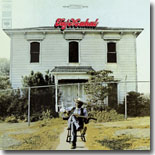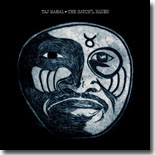|
Taj Mahal
Taj Mahal
The Natch'l Blues
Sony Music |

Few blues fans may realize it some 48 years down the
road, but in 1967 and 1968, Taj Mahal set the blues
world on its ear with a pair of releases that
defined him as one of the major figures in modern
blues. Not only did he play a major role in reviving
and preserving the country blues traditions, he also
revitalized it by updating it for a younger blues
audience, who suddenly found themselves digging
through record stores not for the latest Beatles or
Stones albums, but for vintage recordings of pre-war
blues artists whose work Mahal presented to them for
the first time.
Mahal’s self-titled debut release (originally on
Columbia Records, now Sony Music) sounds as fresh
today as it did in 1967, with compelling reworkings
of eight classic blues tunes….well, they’re classics
now thanks, in part, to his interpretations. For
example, Mahal’s electrified reading of Blind Willie
McTell’s “Statesboro Blues” was so top notch that
Duane Allman virtually copied the guitar intro from
Jesse Ed Davis when the Allman Brothers played it,
and greatly influenced the guitarist to begin
playing slide guitar.
Mahal’s version of Sleepy John Estes’ “Leaving
Trunk” is one of his most recognizable songs., and
he and his cohorts turned Sonny Boy Williamson II’s
“Checkin’ Up On My Baby,” into a swinging rocker.
The second of three Estes cover tunes, “Everybody’s
Got To Change Sometime,” is taken at a break-neck
pace, and the Tennesee blues man’s “Diving Duck
Blues” gets a blues-rock makeover.
Their version of
“Dust My Broom” percolates with a lively exuberance
and sounds like a new song, belying the song’s
origins some 30 to 40 years before. Mahal
only wrote two of the eight tunes for his debut: “EZ
Rider” is a rocking blues amalgam of classic lyrics,
and he amends a blues classic in “The Celebrated
Walkin’ Blues,” a fresh and lively reading which
features only his slide guitar and harp with Ry
Cooder’s mandolin.
Backing Mahal on these tracks were Davis, Cooder,
and Bill Boatman (guitars), Gary Gilmore (bass), and
Sanford Konikoff and Charles Blackwell (drums).
Davis, Gilmore, and Blackwell would also back Mahal
on his next release in 1968, The Natch’l Blues. This
second album retained some of the stripped-down
qualities of Mahal’s debut, but also ventured into
new territory. Part of this is due to the presence
of the keyboards of Al Kooper, which gives the album
an added dimension, such as the upbeat opener, “Good
Morning Miss Brown,” penned by Mahal.
 Another difference in the albums is that Mahal wrote
the majority of songs for The Natch’l Blues.
“Corrina,” co-written with Davis is a gentle and
beautiful country blues that sounds like a vintage
tune, the funky “Going Up To The Country, Paint My
Mailbox Blue” is as funky as can be, and “The
Cuckoo” is one of his most beloved songs. Mahal
adopted Yank Rachell’s “She Caught The Katy and Left
Me a Mule to Ride,” and it’s one of the album’s
standout tracks with its irresistible rhythm.
Another difference in the albums is that Mahal wrote
the majority of songs for The Natch’l Blues.
“Corrina,” co-written with Davis is a gentle and
beautiful country blues that sounds like a vintage
tune, the funky “Going Up To The Country, Paint My
Mailbox Blue” is as funky as can be, and “The
Cuckoo” is one of his most beloved songs. Mahal
adopted Yank Rachell’s “She Caught The Katy and Left
Me a Mule to Ride,” and it’s one of the album’s
standout tracks with its irresistible rhythm.
The most noticeable difference between the two albums
is the final two tracks of the original album. On
those two tracks, William Bell’s “You Don’t Miss
Your Water (‘Til Your Well Runs Dry)” and Homer
Banks’ “Ain’t That A Lot of Love,” Mahal moves into
southern soul territory, which is perfectly fine
because he absolutely nails it. His reading of the
Bell classic is amazing in its emotional depth,
sounding for all the world like it was recorded at
Stax Records during the label’s heyday. The latter
tune borrows the bassline from Spencer Davis’s
“Gimme Some Lovin’,” and Mahal channels Otis Redding
in his vocal.
The Natch’l Blues was reissued in 2000, with three
bonus tracks: a faster version of “The Cuckoo,” the
slow blues “New Stranger Blues,” and a cool
instrumental, “Things Are Gonna Work Out Fine,” that
showcases Davis on guitar and Mahal on harp.
Still active, Taj Mahal has expanded his musical
horizons to explore reggae and Caribbean music,
jazz, R&B, gospel, West African, Latin, and Hawaiian
music over his long career. However, his roots still
run deepest in the blues, the music he first fell in
love with. Taj Mahal and The Natch’l Blues are still
as vital and fresh as they were when they were
initially released and captivated and helped create
a whole new audience of blues fans. They’re both
still essential listening nearly 50 years later.
---
Graham Clarke
Read
Graham's blog